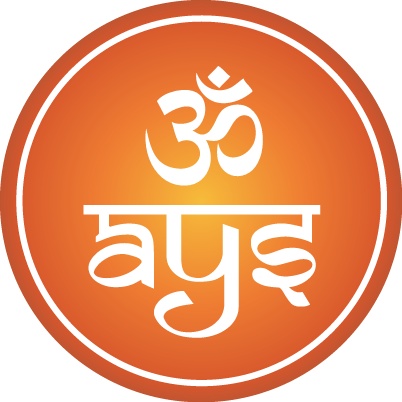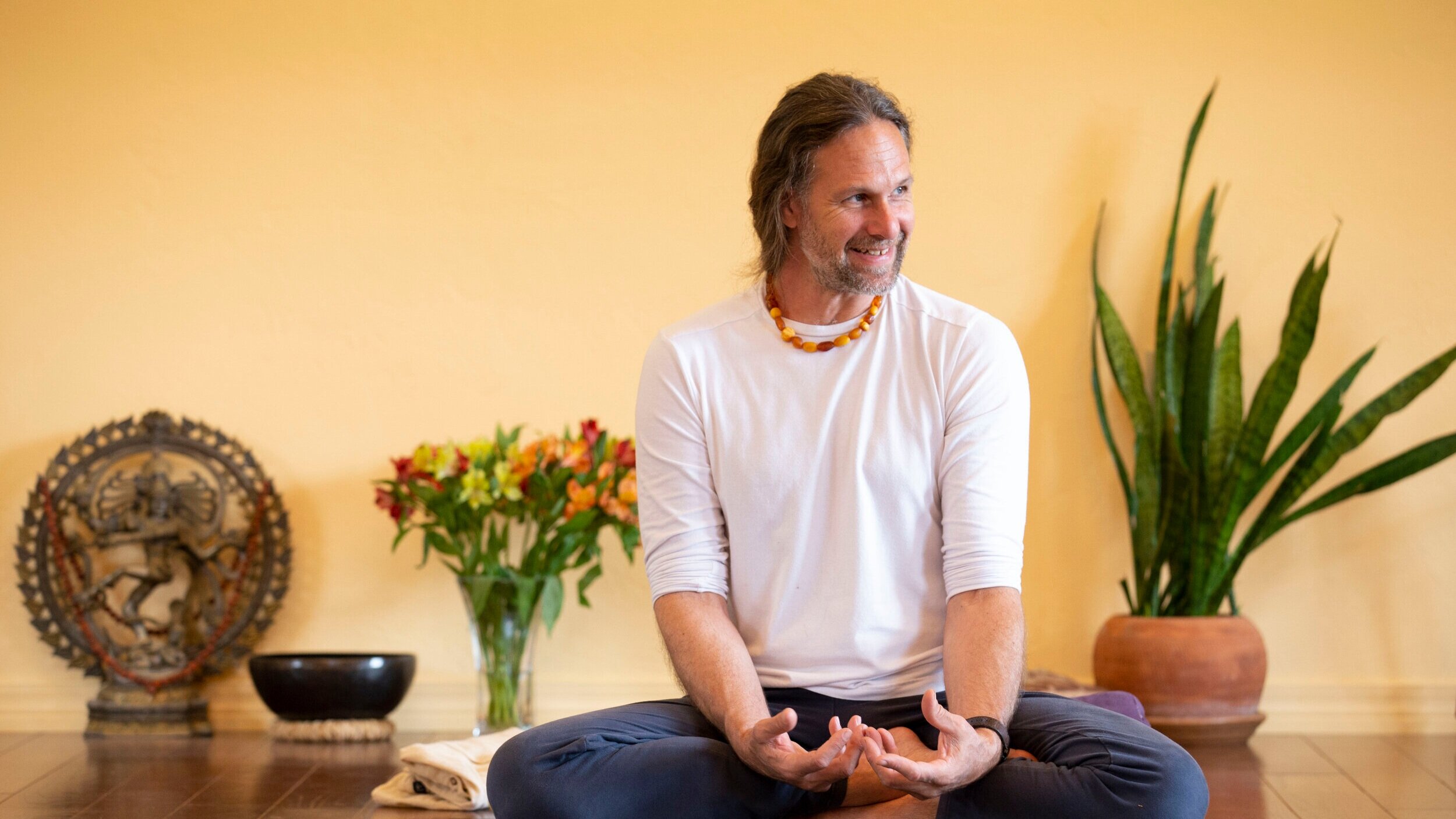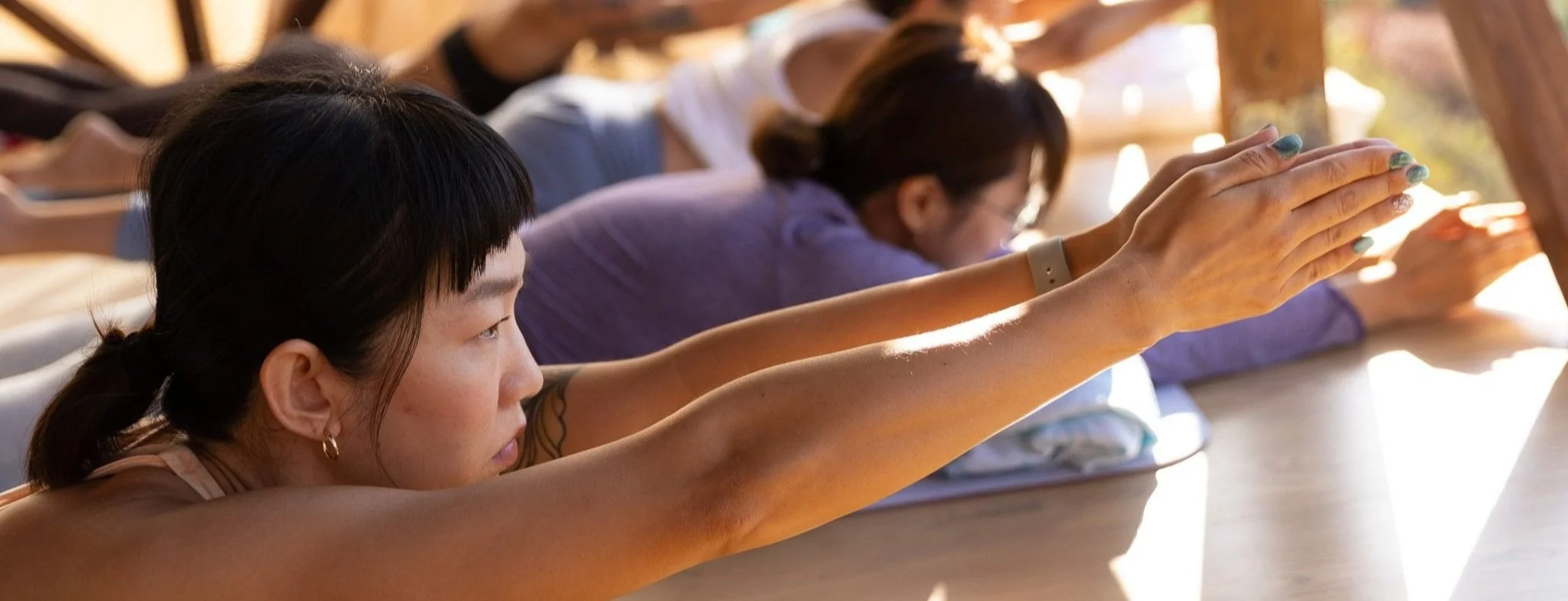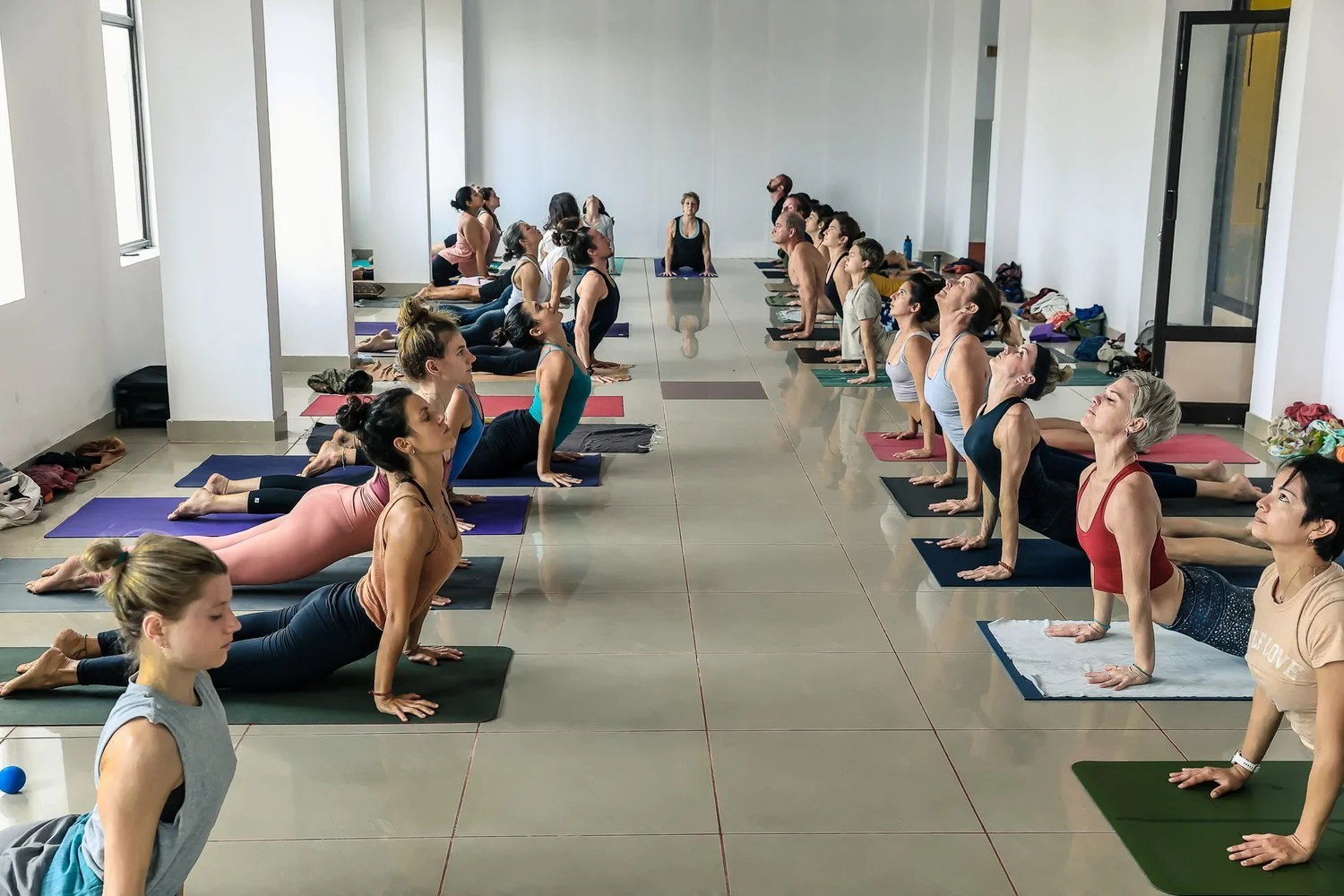200hr Intensive Training
With Andrew Eppler
Welcome to Your Yoga Training!
Congratulations on taking the first step! This course is a comprehensive journey into both the practical and theoretical aspects of yoga, offering a deep dive into the practice of Ashtanga Yoga. You have 12 months to complete the program, and you can progress at your own pace. Each video module is designed to build on the last, starting with the foundational section, which provides a broad overview of the curriculum. Subsequent subcategories will explore key elements in greater depth.
Where to Begin:
I recommend diving into the Philosophy of Ashtanga Yoga Course right away. Treat the videos like podcasts—listen, absorb, and let this rich information deepen your understanding of yoga. It will enhance your experience throughout the training.
Your Personal Practice:
Maintaining a personal yoga practice is essential throughout the training. We also highly encourage engaging in teaching yoga postures, as this will help you internalize the hands-on adjustments taught in the program. Even if teaching is not your goal, consider informally guiding a friend or family member in asanas. This practice will solidify your learning and provide valuable experience.
Crafting Your Personal Practice:
Your personal practice should incorporate three key elements:
Yoga Therapy: Focus on healing your body with mindful movement and care.
Asana: Incorporate at least Surya Namaskar, and ideally, the primary series.
Pranayama/Meditation: Engage in internal work to balance the mind and body.
You are the guide of your own journey. Choose what resonates with you and feel free to explore the various practices offered. As with everything in life, the more you invest in your practice, the more you will reap from this course—and from life itself.
Absorbing the Teachings:
Throughout this training, you’ll be learning from the rich tradition of Indian philosophy, deeply rooted in the Sanskrit community of Mysore. To fully absorb these teachings, I encourage you to regularly watch the Mysore Archive videos. This ongoing exposure will help the knowledge settle and integrate into your consciousness.
This is a community experience! We want to hear your thoughts and ideas as you experience the training. Please join our Whatsapp group to connect with fellow students, ask questions and share your experiences.
Exclusive Access to Our Pranayama Course:
As part of this training, you will also have full access to our Pranayama Course. Begin with the preliminary techniques and focus on developing Breath and Bandha. Starting early will give you ample time to properly integrate these practices into your daily routine.
You can have up to 3 one on one zoom calls with Andrew. These can cover asana practice or any questions you may have about the curriculum etc. It is your responsibility to contact Andrew to set up one on one video conferences. The calls are not manditory but they are available to you. Have a list of any questions you would like to ask prepared beforehand. These will be on Zoom and you can record them for further study. You may email Andrew at any time (okiebaba@gmail.com) with questions or comments as you proceed through the training.
Course Syllabus
This course is designed to take approximately 9 months. You have an additional 3 months if needed.
GRADUATION REQUIREMENTS
Essays on Bhagavad Gita and Patanjali Sutras.
Demonstrate that you have memorized the Primary Series, including the Sanskrit names.
Successful completion of an oral exam via Zoom with Andrew Eppler.
Successful completion of a philosophy exam via Zoom with Dr. MA Alwar from the Maharaja’s Sanskrit College in Mysore India.
For your convenience and simplicity I have divided the videos into four categories. Begin with the foundations section. After that you can choose which area you would like to study next. The information is there but unless you actually use it, it remains only theoretical. I am at your service and will do my best to answer any questions you have as you go through the training. Don’t hesitate to write or schedule a video call.
Links to the other pages of the training
The pages linked above are password protected. Notice the password on the button.
Weekly classes
Every Sunday at 11am CST (18:00 Western Europe and 19:00 Eastern Europe)
You can attend for free. The the zoom code is https://us02web.zoom.us/j/3450843095
Monthly Live Trainings
Join our live trainings and share with us! You are not required to attend the entire time but we very much appreciate if you will log in for the first hour Saturday and Sunday to hear the introductory talk and to meet our group. We are an international group of yogis exploring how yoga can transform our lives. We need your input and we value your opinion! We will make the recordings available to you from each training so that you have them to watch in your own time. They will be shared via Google Drive. If you want permanent access to them you will need to download them. We will delete older recordings them periodically to save space.
Our main zoom link is always the same! https://us02web.zoom.us/j/3450843095
In the Nathamuni Sampradaya, the tradition we follow, it is customary for the teacher to speak without relying on written notes. This is a direct transmission of experience and worldview. I invite you to listen carefully and reflect on what you hear. What you truly internalize is what becomes yours—everything else is simply information available online.
Yes, I may ramble at times! This is part of my teaching style, and if you were to attend my classes in person, you’d experience the same. Treat this as you would any class: take notes on what resonates with you. You don't have to agree with everything I say, and I encourage you to reach out if you feel I’m wrong on any point.
The goal is for you to engage deeply with the material and make it your own. Think critically and reflect on the ideas presented. You have my full support and blessing as long as you stay authentic and true to your own understanding.
Enjoy the journey!
Foundations
Here are some opening thoughts which express my general ideas about the training.
Practice is encouraged! If you are studying remotely you will need to find a way to practice the ideas taught here in order to learn them. These are general ideas which apply to all types of yoga and all types of adjustments.
The main point here is to begin the journey of developing your observation. The longer you teach the more astute your sense of observation becomes. There are things you can work on initially to speed this process. Here we discus some basic ideas that can help with all other techniques taught in the training.
You need to memorize the the Ashatnga Primary sequences as quickly as possible if you have not done so already. Here are some thoughts on this subject.
While we keep the firm goal of learning to practice and teach the primary series of Ashtanga Yoga, this training will take you deep in to Indian philosophy and thought. We want you to feel connected to Mysore’s yoga tradition and to understand the views and ideas which that tradition is based upon. Here are some initial ideas to set the stage for the journey we will take together.
This training is a deep dive into Indian thought and philosophy. Before we start working with the big guys I will do my best to introduce you to what little I have learned so far about the roots of Ashtanga Yoga and the spiritual practices which accompany it.
In the video above we spoke with Sri Lakshmithathachar Swami who was my Acharya and personal spiritual teacher until the time of his death is 2021. He taught me about Mysore Yoga Parampara. The views expressed here came from him. The next video is a further discussion of the things he shared with our group the previous day.
The above is only a brief introduction. You will be listening to much more of Lakshmithathachar as well as his son Sri Alwar who will be giving your final exam in philosophy. In our philosophy and history section you will learn much more.
How does this philosophy intersect with the asana practices we all want to learn and teach? Here are some thoughts on this subject.
Basic Foundations of Sankhya and Yoga
And in further exploration of the energetic side of asana practice of course we must explore Mudra and Pranayama.
Psychology of Teaching
How should we relate to our students? What should the attitude of a teacher be? How can we be our authentic selves? How to convey the information accurately as it was taught to us? Here are some ideas about the issues that yoga teachers all encounter when teaching public classes.
Here is some good advice for a yoga teacher. You may not agree and at times it will be impossible to follow this advice, but keep it in mind as it can save you a lot of trouble!
Nine things you should avoid talking about with yoga students
During our Melkote Retreat Sri Alwar shared a lesson I had not heard before and which stuck in my mind. I asked him later and he told me this saying comes from a category of texts called “Subashita” which simply translates as “good sayings.” It is just a fragment of wisdom from the deep and rich tradition that the yoga of Mysore has come down through. Obviously we will talk about such things with those who are very close to us, but this struck me as a really valuable piece of advice.
Your age. Whether you are young or old, whether you look younger or older than your years, it is simply nobody’s business.
Your health and the medicines you take. If we divulge the details of our personal health people form their own opinions and their attitudes towards us change. It is better to keep such things private.
Your personal practice. Your Asanas, Mantras, Meditation, whatever it is you do, keep it private. Don’t brag when you feel good about your practices and don’t complain when things are not ideal. You weaken whatever you do by discussing it openly with people who have no business knowing these things.
Your money. Talking about how much money you have is just plain bad luck. Bragging about how much or lamenting the lack of money demonstrates need for either praise or sympathy and both make you look bad.
Disagreements within your family. In every family there are bound to be differences of opinion. Whether is is between husband and wife, siblings, parents or in-laws - it is always a mess sometimes. That is humanity. Don’t air dirty laundry. Keep your private life private.
The love affairs you have had. Never discuss your sex life or allude to it. It is poor taste and does nothing for you.
Those who love you. Don’t name drop. Don’t brag of successes or impressing anyone. Let people hear those things from other people if they are to hear them. Bragging about anything simply says “I am insecure and need validation.”
Those who hate you. We all have people who we are not on the best of terms with. Maybe we have outright enemies. Don’t speak ill of anyone. Don’t talk about arguments you won or how much you dislike so and so.
The charity and good deeds you do. Whatever you do for others let it be true karma yoga and don’t talk about it. Again let other people tell about those things if they are noteworthy. It is enough to know we have done a good thing for someone. There is a belief in Indian culture that you actually lose the virtue of your good deeds when you boast about them.
These nine things when observed carefully give the personality strength and stability and instill respect in other people. Don’t try to tell people who you are, let them discover for theirselves and form their own ideas. There is great dignity in this. These ideas are ancient guides for creating successful interactions with others.
In today’s social media driven world we have the opposite idea. People post everything for everyone to see. This idea that “My life is an open book and I am just so comfortable with myself that I can tell everyone everything is naive and foolish. Especially in the context of a yoga teacher interacting with his or her students, these nine observances and very good advice in my opinion!
Therapeutic Techniques
Here we begin to look at patterns in the human body and discuss what chan be done to change them. This is a vast area of study and in this training we will only touch the tip of the iceberg. We each encounter difficulties in our bodies t one time of another. There are some basic tools that a yoga teacher should acquire to help navigate some common situations that arise. Like philosophy of asana this is an endless area of study.
Sharpen your sense of observation! A human being is a walking enciclopedia of information. Tune in and notice what is going on. Here are some basic ideas to help.
Therapeutics - Once we begin to notice our own patterns of asymmetry and imbalance and those of others, the obvious next question is “what do we do about it?” I want to give some simple techniques which are the best, safest and most versatile that I have discovered so far. There is no one set of exercises that works for everyone! Therapeutic exercised have to be customized for each student. This is a level of expertise that takes years to develop and it can be daunting for a new teacher. Don’t worry! We will send you out of this training with some excellent and carefully chosen tools to work with.
Therapeutics - There are two basic categories of methods for this sort of work. One is to show the student how to help themselves. another is to try to help someone with massage and bodywork. This takes time and practice to gain confidence with of course. The best way to learn is to exchange massage with a friend and get honest feedback. Be careful! The techniques taught here are generally quite safe and easy to do. Communication is key! Ask the person to say if anything hurts or feels uncomfortable. Avoid working on anyone who is really injured at first. Be upfront about what you know and what your don’t know. Never say you can fix anyone. Just offer your help and assistance. You will be surprised what you may be able to accomplish! To bring relief and ease of movement to another person is very rewarding. With some practice you will know enough to help many people.
How do we incerperate some of these therapeutic ideas into a practice? Here are some ideas for you to try!
The videos above lay the foundations for the rest of the program. First digest this information. Then follow the links to the other areas of the training.
You have a long journey ahead of you! Enjoy.
Links to the other pages of the training
(passwords provided below)
Yoga methodology
history and philosophy
physiology and healing arts
The pages linked above are password protected. Here are the passwords to access each of them..
YOGA METHODOLOGY: patanjali9
HISTORY AND PHILOSOPHY: narayana108
PHYSIOLOGY AND HEALING ARTS: chikitsa109















